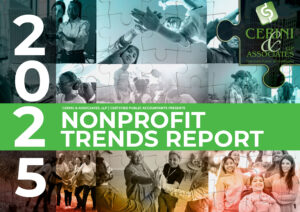As the nonprofit sector faces increasing demands and economic challenges, it’s crucial for organizations to adopt business-like strategies to ensure sustainability and growth. Here are key practices and reasons why nonprofits should make this pivot in 2025:
1.) Aim for a Surplus, Not Just Break-Even
Nonprofits often operate on tight budgets, aiming to break even. However, striving for a surplus can provide a financial cushion, allowing for investment in new programs, staff development, and unforeseen expenses. A surplus can also help build reserves, ensuring long-term stability and the ability to weather economic downturns. According to a report, many nonprofits are seeing higher demand for services while struggling with rising labor costs and the difficulty of recruiting and retaining younger workers.
2.) Nurture Talent
Investing in your team is essential for organizational success. This includes providing professional development opportunities, competitive salaries, and a positive work environment. By nurturing talent, nonprofits can retain skilled employees, reduce turnover, and build a strong, motivated workforce. The hiring crisis that began during the pandemic continues to plague nonprofits, making it crucial to focus on talent retention.
3.) Treat Donors Like Customers
Donors are the lifeblood of any nonprofit. Treating them like valued customers can enhance their experience and increase loyalty. This involves personalized communication, regular updates on the impact of their contributions, and showing appreciation through thank-you notes and recognition events. Building strong relationships with donors can lead to increased donations and long-term support. In 2025, donor fatigue remains a challenge, making personalized and targeted communication even more important.
4.) Focus on ROI
Return on Investment (ROI) is not just a business metric; it’s crucial for nonprofits too. Evaluating the ROI of programs and initiatives helps ensure resources are used effectively and goals are met. This involves setting clear objectives, measuring outcomes, and making data-driven decisions to optimize impact. Data analytics and machine learning can help nonprofits forecast futures and understand donor behaviors.
5.) Implement Strategic Planning
Strategic planning is vital for setting long-term goals and identifying the steps needed to achieve them. This includes conducting SWOT analyses (Strengths, Weaknesses, Opportunities, Threats), setting SMART goals (Specific, Measurable, Achievable, Relevant, Time-bound), and regularly reviewing and adjusting plans based on performance and changing circumstances.
6.) Embrace Technology
Leveraging technology can streamline operations, improve communication, and enhance program delivery. This includes using CRM systems for donor management, data analytics for decision-making, and digital marketing tools to reach a broader audience. Investing in technology can increase efficiency and effectiveness. Nonprofits are expected to continue adopting new digital opportunities to reach their audiences and improve efficiencies.
7.) Monitor and Adapt to Economic Trends
The economic landscape in 2025 is expected to be challenging, with increased demand for nonprofit services due to economic uncertainties and social challenges. Nonprofits must stay informed about economic trends and adapt their strategies accordingly. This includes diversifying funding sources, building partnerships, and exploring new revenue streams. Many financial experts remain optimistic that the economy will improve, which could encourage donor generosity.
8.) Enhance Governance and Compliance
Strong governance and compliance practices are essential for maintaining trust and accountability. This involves having a clear governance structure, regular board meetings, transparent financial reporting, and adherence to legal and regulatory requirements. Good governance ensures ethical practices and enhances credibility with donors and stakeholders.
Why This Pivot is Crucial in 2025
The economic environment in 2025 is likely to be characterized by increased demand for nonprofit services due to economic uncertainties and social challenges. At the same time, funding sources may become more competitive, requiring nonprofits to demonstrate greater efficiency and impact. By adopting business-like practices, nonprofits can:
- Ensure Financial Stability: Building a surplus and diversifying funding sources can provide financial security and enable growth.
- Improve Operational Efficiency: Strategic planning, technology adoption, and ROI focus can optimize resource use and program effectiveness.
- Enhance Donor Relationships: Treating donors like customers can increase loyalty and support.
- Attract and Retain Talent: Investing in staff development can build a strong, committed team.
- Maintain Trust and Accountability: Strong governance and compliance practices ensure ethical operations and enhance credibility.
By making this pivot, nonprofits can better navigate the challenges of 2025, ensuring they continue to fulfill their missions and make a positive impact on the communities they serve.
Matthew Burke, CPA
Partner
Matt specializes in providing Cerini and Associates’ diverse array of midsized business clientele and nonprofit organizations with valuable consulting and assurance services. He prides himself on value-added, responsive, and innovative service to his clients; with a focus on forward-thinking and creative solutions. Matt joined the firm in 2002 and has years of experience with many types of complex accounting, auditing, compliance, and general business matters that impact entrepreneurial, established, and nonprofit businesses.





No comment yet, add your voice below!